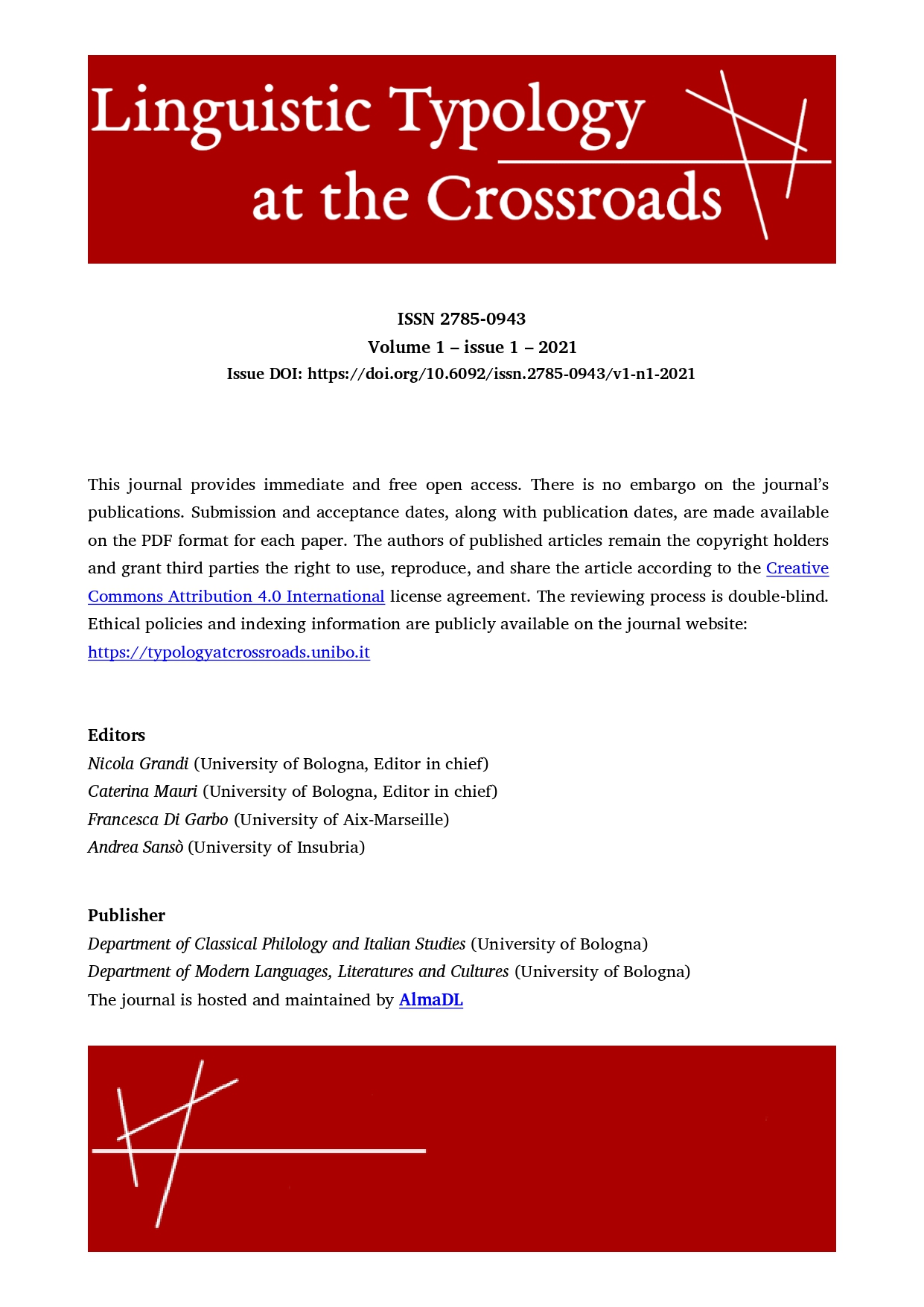Linguistic Typology at the Crossroads
DOI:
https://doi.org/10.6092/issn.2785-0943/13473Keywords:
Linguistic typology, Comparative constructions, Language change, Sociolinguistics, Language contact, Corpus-based analysis, Editorial paperAbstract
Welcome to Linguistic Typology at the Crossroads (LTC), a new journal dedicated to the crossroads where linguistic typology meets its neighboring fields.
A crossroads is not only and necessarily a place where a choice must be made: this is the point of view of the traveler, wondering which way to go. If we take a bird’s-eye view and observe the crossroads from above, we see much more than choices. A Crossroads is the place where different directions, and different travelers, meet or follow each other. Thanks to the crossroads, it is possible to change and exchange, and the very concept of ‘step forward’ opens itself to diagonals and curves. The crossroads is where future is imagined and innovation occurs, thanks to the reciprocal influence of intersecting perspectives.
Crossroads means meeting, exchanging, converging, choosing, diverging, changing, and possibly making the difference.
This journal aims to take the point of view of the crossroads, capturing the moment when linguistic typology intersects other fields, changing and exchanging methods, theories and data, in the belief that a closer look at the crossroads may reveal converging paths and new directions to go.
Downloads
References
Andersen, Paul Kent. 1983. Word Order Typology and Comparative Constructions. Amsterdam / Philadelphia: John Benjamins.
Bybee, Joan L. 2015. Language change. Cambridge / New York: Cambridge University Press.
Croft, William. 2000. Explaining Language Change: An Evolutionary Approach. Harlow: Pearson education.
Croft, William. 2007. The origins of grammar in the verbalization of experience. Cognitive Linguistics 18(3). 339-382.
Cuzzolin, Pierluigi & Lehmann, Christian. 2004. Comparison and gradation. In Geert Booij & Christian Lehmann & Joachim Mugdan & Stavros Skopeteas (eds.), Morphologie. Ein internationales Handbuch zur Flexion und Wortbildung 17.2, 1857–1882. Berlin / New York: Mouton de Gruyter.
Dixon, R.M.W. 2008. Comparative constructions: A cross-linguistic typology. Studies in Language 32(4). 787–817.
Fuchs, Catherine. 2014. La comparaison et son expression en français. Paris: Ophrys.
Haspelmath, Martin. 2021. Explaining grammatical coding asymmetries: Form–frequency correspondences and predictability. Journal of Linguistics 57(3). 605-633.
Hawkins, John A. 2004. Efficiency and complexity in grammars. Oxford: Oxford University Press.
Hawkins, John A. 2014. Cross-linguistic variation and efficiency. New York: Oxford University Press.
Heine, Bernd & Tania Kuteva. 2002. World Lexicon of Grammaticalization. Cambridge / New York: Cambridge University Press.
Keller, Rudi. 1994. On language change: The invisible hand in language. London: Routledge.
Stassen, Leon 1985. Comparison and Universal Grammar. Oxford: Basil Blackwell.
Stolz, Thomas 2013. Competing Comparative Constructions in Europe. Berlin: Akademie-Verlag.
Treis, Yvonne 2018. Comparative Constructions: An Introduction. Linguistic Discovery 16(1). i–xxvi.
Treis, Yvonne & Martine Vanhove (eds). 2017. Similative and Equative Constructions. A cross-linguistic perspective. Amsterdam / Philadelphia: John Benjamins.
Ultan, Russell 1972. Some features of basic comparative constructions. Working Papers on Language Universals (Stanford) 9. 117–162.
Downloads
Published
How to Cite
Issue
Section
License
Copyright (c) 2021 Caterina Mauri; Nicola Grandi, Francesca Di Garbo, Andrea Sansò

This work is licensed under a Creative Commons Attribution 4.0 International License.





